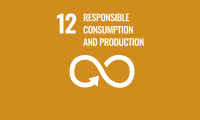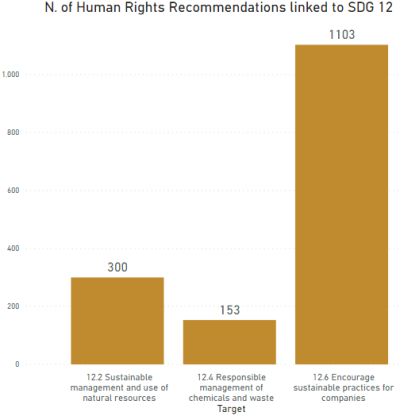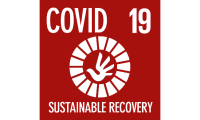SDG 12 and Sustainable Recovery

Key aspects of SDG 12:
1. Ensure sustainable consumption and production patterns (targets 12.2, 12.c among others)
The COVID-19 pandemic occurs amidst a wider planetary crisis and ecological disaster caused by the degradation of natural resources and associated biodiversity loss, which are also increasing pandemic risks. Shifting to sustainable consumption and production and decoupling economic growth from environmental degradation would address the key drivers of ecosystem disruption, biodiversity loss, resource depletion, and climate change. Sustainable consumption and production can also contribute substantially to poverty alleviation and improve worker and public health.
Applying resource efficiency and circularity to the design, sourcing, production and use of products also helps build resilience against future systemic shocks.
Sustainable response and recovery actions:
In designing recovery plans and responses to the pandemic, governments and investors should avoid providing stimulus based on business-as-usual. These plans and packages should be designed to sustain the natural resource base and ecosystems that underpin the global economy, while ensuring the protection of vulnerable populations; safe, nutritious food at affordable prices; the creation of green jobs; and a just transition for all.
A transformative COVID-19 recovery must trigger investment, policy and behavioural changes that reduce the likelihood of future shocks and increase society’s resilience when they do occur. This also includes phasing out fossil fuel subsidies (SDG target 12.c).
International Covenant on Economic, Social and Cultural Rights (ICESCR), 12.1: The States Parties to the present Covenant recognize the right of everyone to the enjoyment of the highest attainable standard of physical and mental health
International Covenant on Economic, Social and Cultural Rights (ICESCR), 1.2: All peoples may, for their own ends, freely dispose of their natural wealth and resources without prejudice to any obligations arising out of international economic co-operation, based upon the principle of mutual benefit, and international law. In no case may a people be deprived of its own means of subsistence.
United Nations Declaration on the Rights of Indigenous Peoples (UNDRIP), art. 26.1: Indigenous peoples have the right to the lands, territories and resources which they have traditionally owned, occupied or otherwise used or acquired.
United Nations Declaration on the Rights of Indigenous Peoples (UNDRIP), art. 29.1: Indigenous peoples have the right to the conservation and protection of the environment and the productive capacity of their lands or territories and resources. States shall establish and implement assistance programmes for indigenous peoples for such conservation and protection, without discrimination.
2. Promote responsible business conduct and sustainable procurement practices (12.6, 12.7)
Responsible business conduct can play a key role in sustainable recovery. However, studies have shown that, despite progress, a gap remains between current business practice and what business should be doing to realise the SDGs and respect human rights. The World Benchmarking Alliance has studied 229 companies in the extractives, ICT manufacturing, apparel, autos, and agriculture sectors and found that in spite of some positive examples, most companies failed to demonstrate that their response to the pandemic was adequate to limit negative impacts on stakeholders, especially in their supply chains, and to ensure that their rights were respected.
Public procurement can drive sustainable transformation and contribute to fulfilling human rights of workers in supply chains and end users of goods and services. During the pandemic, the purchase of goods and services like personal protective equipment, medicines, ventilators and tracking apps is key to realising patients’ right to health and life. The pandemic has also posed specific challenges to sustainable procurement. Procuring under emergency measures to meet massive and urgent needs has meant that normal protections have been suspended. This is often combined with fast and flexible delivery dates which workers are under pressure to meet, causing risks of labour rights abuses of workers producing goods and services. Protecting the right to life and health of populations with limited health budgets, while prices of medical supplies are driven up is another challenge.
Sustainable response and recovery actions:
Sustainable business conduct is not only the “right thing to do” for people and planet but is increasingly also a good business case, as the market for sustainable products is growing while there are gains to be made from embedding circularity in production.
It is important that businesses comply with the UN Guiding Principles on Business and Human Rights and conduct human rights due diligence, even in times of crisis.
Public procurement practices must be sustainable i.e. prioritize procurement from suppliers who respect the three dimensions of sustainable public procurement: economic, environmental and social (i.e. human rights).
Good practices include implementing transparency tools to enable the public to scrutinize public procurement decisions and suppliers (for example through digital platforms with information on suppliers and their supply chains); incorporating human rights standards in tender documents and contracts; issuing guidelines for emergency purchases; including small and medium enterprises and vulnerable groups as suppliers; contracting businesses to expand public infrastructure to ensure access to goods and services.
Visit the documents and resources listed in the “Key Human Rights Guidance” below for more information.
Universal Declaration of Human Rights (UDHR), art. 23.1: “Everyone has the right to work, to free choice of employment, to just and favourable conditions of work and to protection against unemployment”.
Universal Declaration of Human Rights (UDHR), art. 23.4 “Everyone has the right to form and to join trade unions for the protection of his interests”.
International Covenant on Economic, Social and Cultural Rights (ICESCR), art. 12.1 “The States Parties to the present Covenant recognize the right of everyone to the enjoyment of the highest attainable standard of physical and mental health.
Art. 12.2 The steps to be taken by the States Parties to the present Covenant to achieve the full realization of this right shall include those necessary for:
Art. 12.2.b The improvement of all aspects of environmental and industrial hygiene”.
International Labour Organisation (ILO) 105, art. 2 “Each Member of the International Labour Organisation which ratifies this Convention undertakes to take effective measures to secure the immediate and complete abolition of forced or compulsory labour as specified in article 1 of this Convention”.
International Labour Organisation (ILO) 87: Art. 11: “Each Member of the International Labour Organisation for which this Convention is in force undertakes to take all necessary and appropriate measures to ensure that workers and employers may exercise freely the right to organise”.
International Labour Organisation (ILO) 98 art. 1. “Workers shall enjoy adequate protection against acts of anti-union discrimination in respect of their employment”.
International Labour Organisation (ILO) C111 Discrimination (Employment and Occupation) Convention: This fundamental ILO Convention defines discrimination as any distinction, exclusion or preference made on the basis of race, colour, sex, religion, political opinion, national extraction or social origin, which has the effect of nullifying or impairing equality of opportunity or treatment in employment or occupation.
International Labour Organisation (ILO) C187 Promotional Framework for Occupational Safety and Health Convention: This ILO Convention requires ratifying states to promote continuous improvement of occupational safety and health to prevent occupational injuries, diseases and deaths, by the development of a national policy, national system and national programme.
International Labour Organisation (ILO) C155 Occupational Safety and Health Convention: The convention provides for the adoption of a coherent national occupational safety and health policy, as well as action to be taken by governments and within enterprises to promote occupational safety and health and to improve working conditions. This policy shall be developed by taking into consideration national conditions and practice. The Protocol calls for the establishment and the periodic review of requirements and procedures for the recording and notification of occupational accidents and diseases, and for the publication of related annual statistics.
International Labour Organisation (ILO) C29 Forced Labour Convention: This fundamental Convention requires ratifying states to suppress the use of forced or compulsory labour in all its forms within the shortest possible period.
International Labour Organisation (ILO) C105 Abolition of Forced Labour Convention: This fundamental ILO Convention requires ratifying states to take effective measures to secure the immediate and complete abolition of forced or compulsory labour.
International Labour Organisation (ILO) C138 Minimum Age Convention: This fundamental ILO Convention sets the general minimum age for admission to employment or work.
International Labour Organisation (ILO) C182 Worst Forms of Child Labour Convention: This fundamental ILO Convention requires states to eliminate the worst forms of child labour; to provide direct assistance for the removal of children from the worst forms of child labour and for their rehabilitation and social integration.
Key Human Rights Guidance
-
Salient Human Rights Issues on Business and Human Rights, Danish Institute for Human Rights, website
-
Building resilient value chains post COVID-19 (SDG 12), One Planet network, Awareness Raising, 2020
-
World Economic Situation and Prospects 2021, United Nations, Report, 2021

Explore all Recommendations from human rights monitoring mechanisms linked to SDG 12 by country

